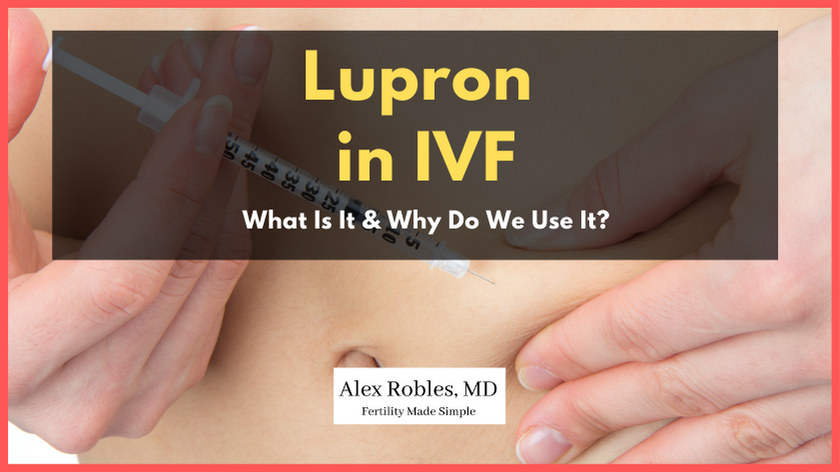Leuprolide acetate, aka Lupron, is a medication often used during the in vitro fertilization process.
In this post, you will learn:
- What Lupron does in IVF
- The different protocols where you can use it
- Side effects you might experience with this medication
Let’s get started.

What does lupron do for IVF?
Lupron is an injectable medication that is used to:
- potentially stimulate more follicles to develop during a stimulation cycle (short term use),
- suppress your ovaries from growing follicles before starting specific protocols (long term use),
- prevents premature ovulation of your developing follicles, or
- trigger your follicles to mature before an egg retrieval
Leuprolide is a gonadotropin-releasing hormone (GnRH) agonist, meaning it can induce the release of Follicle Stimulating Hormone (FSH) and Luteinizing Hormone (LH) from your pituitary gland.
However, if given for more than a few days, it begins to inhibit the pituitary gland from secreting LH and FSH.
So it works as an agonist in the short term and then an antagonist in the long term.
Let’s go over these in more detail.
The Lupron IVF protocol
A typical IVF cycle uses two medications.
- Gonal F or Follistim (which are FSH)
- Menopur (which is a combination of FSH and LH)
However, Leuprolide can be added as a third injection.
When administered as a daily dose at the beginning of an IVF treatment cycle, Lupron can potentially stimulate more follicles to grow during ovarian stimulation.
This treatment protocol is known as a “microdose flare.”
The initial injections of Lupron stimulate the pituitary gland to secrete its own natural FSH and LH (aka a flare), in addition to the FSH and LH you get from the other two injectable fertility medications.
After a few days, the Lupron will then become an antagonist and prevent your pituitary from prematurely causing the ovulation of your follicles.
This protocol is typically reserved for a patient with diminished ovarian reserve or a “poor responder.”
How much Lupron do you take for a microdose flare IVF protocol?
Typically, you will inject 20 units of Lupron twice a day in the microdose flare protocol.
20 units of Lupron = 1 mg = 0.2 mL
The luteal Lupron IVF protocol
The luteal lupron protocol, aka the long lupron or lupron downregulation, is another way to use this medication.
In this protocol, you will begin daily Lupron injections about one week before your period (a few days after you ovulate).
When you get your period, you will begin your stimulation medications (FSH and LH), and you will stop the lupron altogether (aka the Lupron stop protocol), or you will reduce the dose of the Lupron.
*Some fertility specialists may continue the Lupron for at least two weeks or more before starting the FSH and LH injections. This situation is reserved for patients with endometriosis*
This luteal Lupron protocol can be beneficial to prevent follicles from growing asynchronously or for patients who are prone to growing ovarian cysts.
This protocol is not ideal for patients at high risk of ovarian hyperstimulation syndrome (OHSS). The antagonist protocol has largely replaced the luteal lupron protocol.
How much Lupron do you take in the luteal Lupron IVF protocol?
In the luteal Lupron protocol, you will typically inject 20 units subcutaneously daily until you begin your gonadotropin injections.
Once you start the stimulation injections, you will typically decrease the dose of Lupron to 5 mcg daily.
20 units of Lupron = 1 mg = 0.2 mL
5 units of Lupron = 0.25 mg = 0.05 mL
Lupron as an IVF trigger
Lupron can also be used as a trigger before your egg retrieval, either alone or combined with a human chorionic gonadotropin (hCG) trigger.
Once your follicles have reached an appropriate size, Lupron can be administered ~36 hours before the egg retrieval to induce maturation of your oocytes.
This one-time injection causes your pituitary to release a surge of LH and FSH, which is necessary for egg maturation.
A Lupron trigger is highly beneficial for patients at high risk of developing OHSS.
Unfortunately, you cannot use a Lupron trigger if you used Lupron during the stimulation cycle (aka a microdose flare or a luteal lupron protocol).
Lupron Embryo Transfer Cycle
There is one last way to use Lupron in IVF, before a frozen embryo transfer (FET).
In this protocol, you start Lupron in the luteal phase, just like in the long luteal Lupron cycle.
Once you get your period, you will decrease the dose of lupron and start an estrogen medication to help your uterine lining grow.
You then stop Lupron after about a week or so, and you will then begin progesterone injections prior to the embryo transfer.
*Some fertility specialists may continue the Lupron for at least two weeks or more before starting the estrogen tablets. This situation is reserved for patients with endometriosis*
Why do you take Lupron before embryo transfer?
Lupron is taken before a frozen embryo transfer to reduce the risk of growing a follicle and ovulating.
Ovulating during a medicated frozen embryo transfer cycle will completely throw off our timing and make it difficult to do the transfer during the window of implantation.
Typically, your reproductive endocrinologist would only use this cycle if you have had a history of growing follicles despite taking suppression medications (birth control pills).
Other Related Questions
How long do you take Lupron for IVF?
The length of time you take Lupron depends on which protocol you are using.
- Microdose Flare Protocol: You will take Lupron for the entire duration of the stimulation cycle (~8-12 days)
- Luteal Lupron Protocol: You will take Lupron for ~1 week prior to the IVF start and then for the entire duration of the stimulation cycle
- Lupron Trigger: The trigger is only a one-time injection when used as a trigger
- Embryo Transfer Cycle: You will take Lupron for ~1 week prior to the FET start and then for ~1 week before starting progesterone
How often do you take Lupron for IVF?
Lupron is taken daily for the entire duration of a stimulation cycle or ~2 weeks when doing an embryo transfer cycle.
If you use the Lupron injection as a trigger shot, you only need to take it once.
Lupron side effects
Lupron temporarily shuts off your pituitary’s ability to release gonadotropins, which are necessary for follicle growth, ovulation, and menstruation.
If Lupron is taken long-term (~ 1 month or more), you may develop symptoms of low estrogen levels, including hot flashes, mood swings, and vaginal dryness.
If taken for more extended periods, lupron can decrease bone density and increase the risk of osteoporosis. This is why providers use “add-back therapy” (aka estrogen replacement) if they expect to use Lupron for long periods.
In essence, you can think of Lupron as creating a temporary menopause state.
Can you drink while on Lupron for IVF?
In general, it is a good idea not to consume alcohol during an IVF stimulation cycle.
Does Lupron improve egg quality?
Lupron does not improve egg quality. Unfortunately, there are no scientifically proven methods to improve egg quality.
Does Lupron help implantation?
However, there was no difference in actual live birth rates.
More studies are needed to determine if Lupron is beneficial for implantation.
Will I get my period while on Lupron for IVF?
Yes, you will get your period if you are undergoing an IVF cycle that uses Lupron. Your period comes as a result of a rise followed by a fall in progesterone levels, which naturally happens in both a menstrual cycle and an IVF cycle. Lupron will not affect this.
How many units are in a 2 week Lupron kit?
A 2 week Lupron kit contains 280 units. 20 units (1 mg) = 0.2 mL.
Final Words on Lupron Therapy
Lupron is a GnRH agonist used as a potent fertility medication to stimulate the pituitary gland in the short term and suppress it in the long term.
Given its wide array of medical uses, the use of Lupron is beneficial for a variety of IVF protocols, including:
- long luteal,
- microdose flare,
- frozen embryo transfer,
- and as a trigger shot.
Always be sure to speak with your healthcare provider about the benefits of this medication in your fertility treatment.
References
- Hornstein MD, Surrey ES, Weisberg GW, Casino LA. Leuprolide acetate depot and hormonal add-back in endometriosis: a 12-month study. Lupron Add-Back Study Group. Obstet Gynecol. 1998 Jan;91(1):16-24. doi: 10.1016/s0029-7844(97)00620-0. PMID: 9464714.
- Check JH, Choe JK, Cohen R, Summers-Chase D. Effect of taking a one time injection of one mg leuprolide acetate three days after embryo transfer on pregnancy outcome and level of first beta human chorionic gonadotropin (beta-hCG) level. Clin Exp Obstet Gynecol. 2015;42(5):568-70. PMID: 26524798.
- Check JH, Wilson C, Cohen R, Choe JK, Corley D. Mid-luteal phase injection of subcutaneous leuprolide acetate improves live delivered pregnancy and implantation rates in younger women undergoing in vitro fertilization-embryo transfer (IVF-ET). Clin Exp Obstet Gynecol. 2015;42(4):427-8. PMID: 26411204.
Make An Appointment With Dr. Robles To Discuss Your Fertility Options Today!

Alex Robles, MD
Dr. Alex Robles is a Spanish-speaking Latino-American Reproductive Endocrinologist and Infertility specialist in New York City, and a board-certified OBGYN. He has a special interest in health, lifestyle, & nutrition. Make an appointment with Dr. Robles to discuss your fertility options today!
